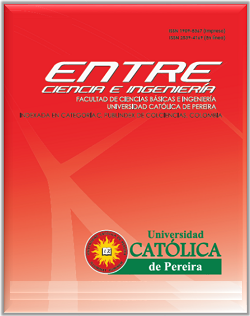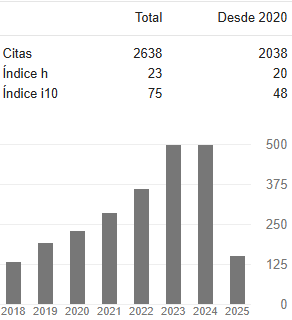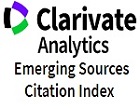Spectrum Sensing with Matrix Completion IZMA-SD for Cognitive Radio Networks
DOI:
https://doi.org/10.31908/19098367.1165Keywords:
Cognitive radio, Interest zone matrix approximation, matrix completion, nuclear norm, spectrum sensing, singular value decomposition, Standard deviation, sub-NyquistAbstract
Due to the growth of wireless networks, efficient use of the spectrum is necessary, a solution is Cognitive Radio. In one of the stages of this technology, spectrum sensing is carried out, that is, determining on a frequency whether there are primary users and, if they do not exist, occupying the available spectrum;this is achieved by applying sensing techniques, each technique requires hardware resources and can identify different characteristics of a signal. Nowadays, high propagation frequencies are used, it is necessary for the processing stage to perform a Sub Nyquist sampling, that is, less than twice the maximum frequency. An alternative solution is to use an algorithm based on Matrix Completion, called by the authors like IZMA-SD. The results show that in different signals sampled at% 75 of Nyquist and under different SNR, when the algorithm is applied, the reconstruction of the signal is performed, to which the sensing techniques can be applied.
Downloads
References
Cisco. “White Paper: Cisco Visual Networking index: Forecast and Methodology, 2015-2010”. Disponible en: http://www.cisco.com/c/en/us/solutions/collateral/service-provider/visual-networking-index-vni/complete-white-paper-c11-481360.pdf. San José, California, USA, 06/07/2016.
Locke, G., and Strickling, L. E. “Plan and timetable to make available 500 Megahertz of spectrum for wireless broadband.” US Department of Commerce, Washington, DC, USA (2010).
FCC Spectrum Policy Task Force (SPTF), “Report of the Spectrum Efficiency Working Group”, United States, November 2002.
Shared Spectrum Company, “General Survey of Radio Frequency Bands – 30 MHz to 3 GHz”, Vienna, Virginia, United States, September 2010.
Rory, V. “A Framework for Radio Frequency Spectrum Measurement and Analysis”, Technical Report, the University of Kansas, United States, March 2008.
Mitola, J., Maguire, G. Q. “Cognitive Radio making software radios more personal”, IEEE Personal Communicant, Vol 6, No. 4, pag. 13-18, September 1999.
Mitola, J. “Cognitive Radio an Integrated Agent Architecture for Software Defined Radio”, Dissertation Doctor Technology, Royal Institute of Technology (KTH), Sweden, ISSN 1403-5286, May 2000.
Haykin, S. “Cognitive Radio: Brain-Empowered Wireless Communications”, IEEE Journal On Selected Areas In Communications, Vol. 23, No. 2, February 2005.
Aguila, J. H. “Radio Cognitiva- Estado del arte”, Universidad Icesi, Revista Sistemas y telemática, vol. 9, No.16, 2011.
NTIA, “United States Frequency Allocation Chart”, [online] https://www.ntia.doc.gov/files/ntia/publications/spectrum_wall_chart_aug2011.pdf.
Pawełczak, P. “Cognitive Radio: Ten Years of Experimentation and Development,” IEEE Communications Magazine, vol. 49, no. 3, pag. 90-100, Mar. 2011.
Peha, J. "Sharing Spectrum Through Spectrum Policy Reform and Cognitive Radio," Proceedings of the IEEE, vol. 97, pag. 708-719, April 2009.
Subhedar, M., y Birajdar G.” Spectrum Sensing Techniques In Cognitive Radio Networks: A Survey”, International Journal of Next Generation Networks, vol. 3, No. 2, June 2011.
Christopher, J., Krishnan, V., y Bagubali, A. “Cognitive Radio: Spectrum Sensing Problems in Signal Processing”, International Journal of computer applications, vol. 40, No. 16, February 2012.
Rozeha, A., and Norsheila, F.”Issues Of Spectrum Sensing In Cognitive Radio Based Systems”, Available: http://trg.fke.utm.my/members/rozeha/2_09.pdf Telematic and Optic Department, Faculty of Electrical Engineering, University Technology Malaysia.2010.
Tevfik, Y., and Huseyin, A. “A Survey of Spectrum Sensing Algorithms for Cognitive Radio Applications”, IEEE Communications Surveys & Tutorials, Vol. 11, No. 1, Pag. 116-130, First Quarter 2009.
Hongjian, S., et al. "Wideband spectrum sensing for cognitive radio networks: a survey." IEEE Wireless Communications 20.2 (2013): 74-81.
Zhi, Q., et al. "Optimal multiband joint detection for spectrum sensing in cognitive radio networks." IEEE Transactions on Signal Processing 57.3 (2009): 1128-1140.
Hong, H., et al. "Applications of compressed sensing in communications networks." arXiv preprint arXiv:1305.3002 (2013).
Candes, E. J., and Recht B. "Exact Matrix completion via convex optimization. Foundations of Computational mathematics, 9(6), 717.
Shabat, G., & Averbuch, A. Interest zone matrix approximation. Electronic Journal of Linear Algebra, 23(1), 50 (2012).
Waleed, E.” Spectrum Sensing in Cognitive Radio Networks”. Tesis de maestría, faculty of Computer Engineering Department College of Electrical and Mechanical Engineering, National University of Sciences and Technology, Pakistan, 2008.
Downloads
Published
Issue
Section
License
Copyright (c) 2025 Entre ciencia e ingeniería

This work is licensed under a Creative Commons Attribution-NonCommercial 4.0 International License.



















